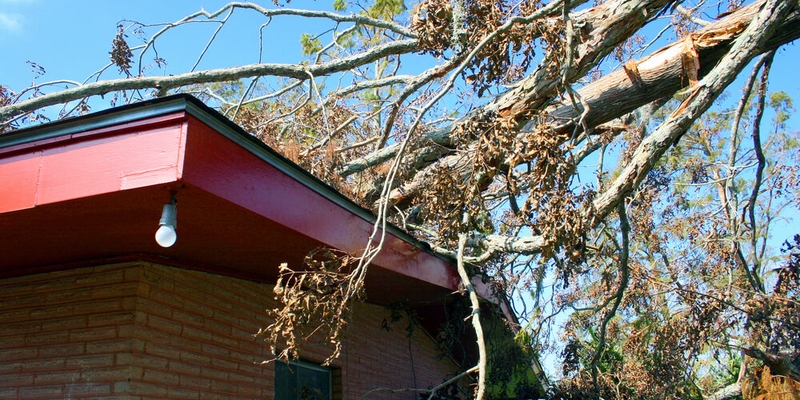
If you are not redirected within 30 seconds, please click here to continue.
Samedi: 10h – 16h HAE

If you are not redirected within 30 seconds, please click here to continue.
If you are not redirected within 30 seconds, please click here to continue.
What happens if your neighbour’s tree falls on your home?

The damage from a neighbour's tree crashing down onto your property can be an upsetting to witness – and surprisingly complicated to navigate. While the immediate concern is the destruction caused, understanding liability and the most relevant insurance coverage can add another layer of complexity to an already fraught situation. Depending on the various factors at play, here’s what homeowners need to know if they find themselves in this situation.
Determining liability is not always straightforward
When it comes to dealing with a tree that falls on your home, the first question to address is liability. Who is responsible for the damage caused by the fallen tree? The answer, unfortunately, is not always straightforward and depends on several factors, including how and why the tree fell.
“Just because you own a tree doesn't mean that you're legally liable for damages that it could have caused,” says Rob de Pruis, national director of consumer and industry relations at the Insurance Bureau of Canada (IBC).
If the tree fell due to an unforeseen event, such as a severe windstorm or natural disaster, the owner of the tree is generally not considered liable. In such cases, the damage is often deemed a result of an unavoidable act of nature, and the affected homeowner's insurance policy would typically cover the repairs, says de Pruis.
“In order for the person who has damage to recover or get funds from someone else, that person or entity would have to be negligent,” he adds.
If negligence is involved, such as the tree being old, rotten, or improperly maintained, the owner of the tree may be held accountable. For instance, if a homeowner fails to address concerns raised by neighbours about the condition of a tree on their property, de Pruis says that they may be considered negligent if it later falls and causes damage. In such cases, the homeowner's insurance policy may be held accountable for covering the resulting damages.
Once liability is determined, the next step is understanding how insurance coverage comes into play. If your home sustains damage from a neighbour's fallen tree, de Pruis says the first course of action is to contact your insurance company and initiate the claims process.
Even if your neighbour is ultimately found liable for the damage caused by their tree falling on your home, it’s important to start the claims process to avoid any delays in repairing the damage. The earlier you notify your insurance company, the better.
“First of all, your insurance company will be able to fix the damage,” says de Pruis. “You probably have replacement cost coverage, so they'll just be able to fix everything up. And then once they've fixed everything up and paid for it, they will try to recover from whoever's at fault. So, they'll explore that negligence piece.”
In cases where negligence is established, and the neighbour's insurance policy is deemed liable, your insurance company may seek reimbursement through a process called subrogation. This involves your insurer pursuing compensation from the responsible party or their insurance provider to cover the cost of repairs.
What if no one is found liable for the damage?
Homeowners typically have comprehensive insurance policies that cover a wide range of perils, including damage caused by fallen trees on their property due to windstorms or natural events.
However, the extent of coverage may vary depending on the specific terms of your policy. Some policies may only cover damage caused by specified perils, while others offer more comprehensive coverage. Additionally, some insurance policies have a section called ‘voluntary property damage. ’
This can come in handy if it’s your tree that falls on a neighbour’s home.
“If you are not legally liable, but you just feel bad because it's a good neighbour and you want to keep good relations, you can pay for the property damage to your neighbour's house voluntarily,” says de Pruis. “There's usually a specific limit or a maximum amount that's covered, but that's another option that you have.”
Additional considerations
Other factors can further complicate the situation, such as the involvement of commercial businesses or municipal-owned trees. Thankfully, in these scenarios, often the damage can be covered by someone else’s insurance.
For example, explains de Pruis, if a tree service company negligently cuts down a tree, causing damage, their commercial liability insurance may be responsible for covering the costs.
When dealing with city-owned trees, different liability laws and reporting procedures may apply but will likely be covered by the municipality.
“Depending on the jurisdiction, there's typically some type of municipal government act that outlines situations about liability,” says de Pruis. “You’ll have finite time periods to report the claim – usually 30 days – and that legislation essentially gives some broader protections to the municipality.”
Similarly, if a tree falls due to a collision with a vehicle, the driver's auto insurance policy may come into play, says de Pruis.
Understanding replacement value
In the aftermath of a fallen tree damaging your home, one crucial aspect to consider is the replacement value of damaged property. While insurance policies typically cover the cost of repairs, it's essential to understand whether your coverage includes replacement cost or actual cash value.
Replacement cost coverage ensures that your insurance provider will cover the full cost of repairing or replacing damaged property without factoring in depreciation.
This means that if a tree damages your roof, for example, your insurance company will cover the cost of repairing or replacing the roof with a new one of similar quality and materials, regardless of its age or condition prior to the damage.
Alternatively, actual cash value (ACV) takes depreciation into account when determining the value of the damaged property. In this case, the insurance payout may be reduced to reflect the decreased value of the property due to age, wear and tear, or other factors.
As a result, homeowners with ACV coverage may receive a lower payout than the actual cost of repairs or replacement, potentially leaving them with out-of-pocket expenses.
Learn more: Actual cash value vs. replacement cost home insurance policies: what’s the difference?
How to spot signs of a perilous tree
Identifying signs of a hazardous can significantly lower the risk of ever having to be in this unfortunate situation. Regular inspection by a certified arborist can help identify these signs early, allowing for appropriate action to mitigate risks. Here are some indicators to watch for:
- Leaning: Trees leaning steeply to one side may be unstable and at risk of falling.
- Dead or decaying branches:Dead or decaying branches, evidenced by lack of leaves or fungus growth, pose a falling hazard.
- Root damage:Exposed roots, soil heaving, or disrupted ground around the base of the tree may signal root damage.
- Hollow trunk or large holes:A hollow or decayed trunk compromises the tree's stability and increases the risk of collapse.
- Disease or pest infestation: Symptoms such as abnormal growth patterns, discolored foliage, or bark damage may indicate disease or pest infestation, weakening the tree's health.
- Overhanging branches: Branches extending over structures, pathways, or utility lines pose a potential threat if they break.
- Oozing sap:Too much sap, especially on the trunk, can happen if birds or insects damage the tree. It can also be caused by an infection and be a sign that a tree is in poor health.
Always review your policy
Given the importance of having adequate coverage for tree-related damage, homeowners should carefully review their insurance policies to understand the terms and coverage limits.
When in doubt, consult with your insurance provider or agent to clarify any questions and to ensure that your policy adequately protects against the full cost of tree-related damage.
By proactively assessing your insurance coverage, you can better prepare for unforeseen events such as a neighbour's tree falling on your home.
Don't waste time calling around for home insurance
Use RATESDOTCA to shop around and compare multiple quotes at the same time.
Finding the best home insurance coverage has never been so easy!
Get money-saving tips in your inbox.
Stay on top of personal finance tips from our money experts!










